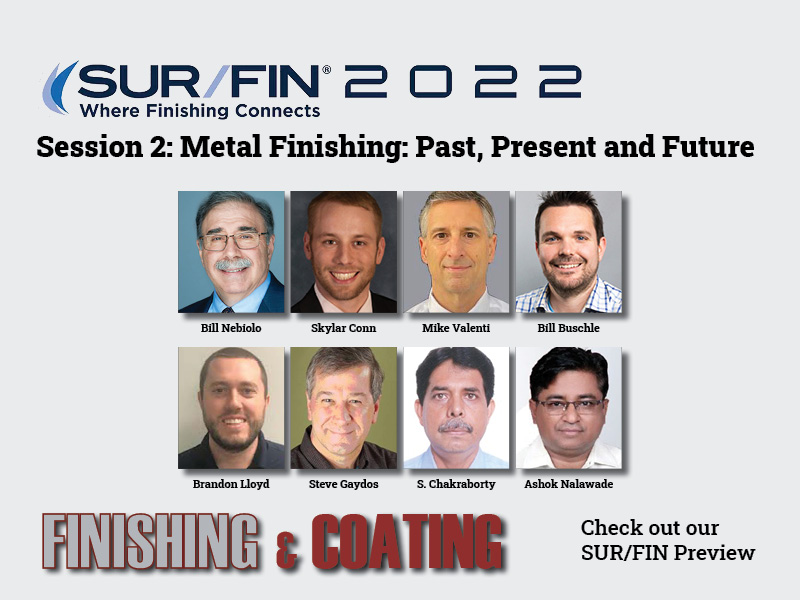Session 2 at the NASF SUR/FIN Technical Conference will be on “Metal Finishing: Past, Present and Future.”
Here are the abstracts for the presentations. Please visit www.nasfsurfin.com for information on registering for the event:
Tuesday, June 7: Session Chairs Caleb Morrison, Atotech USA, and Fernando Carminholi, Hubbard-Hall
8:30 – 9:00: The History of Electroplating and NASF — Bill Nebiolo, REM Surface Engineering
 Bill NebioloThe History of Electroplating will be an enjoyable visit to our industry's past. Join me as I explore the twists and turns related to the past 240-years of our industry. I'll peek into the individuals who made our technology possible and review their work as it relates to the advancement of the science of electroplating. I'll review their famous experiments and discoveries both deduced and serendipitous that brought us into the field of modern electroplating.
Bill NebioloThe History of Electroplating will be an enjoyable visit to our industry's past. Join me as I explore the twists and turns related to the past 240-years of our industry. I'll peek into the individuals who made our technology possible and review their work as it relates to the advancement of the science of electroplating. I'll review their famous experiments and discoveries both deduced and serendipitous that brought us into the field of modern electroplating.
9:00 – 9:30: Understanding the Key Process Variables of Hydrogen Embrittlement in Chemical Processes — Skylar Conn, Rolls-Royce
 Skylar ConnIt is of significant interest to heavy industries which rely on high strength steels to understand which process variables contribute the highest risk to degradation modes such as hydrogen embrittlement. Further, the cost of non-quality can be lowered by understanding which variables within a chemical process contribute to these risks. Hydrogen embrittlement is a degradation mechanism for high-strength steels from hydrogen generated during certain processes. The aerospace industry is highly concerned about this phenomenon. The risks associated with this degradation phenomenon are managed via empirical methods such as baking to relieve the hydrogen from the substrate, however, the exact contributors to hydrogen embrittlement within a chemical process are not well understood. For example, within any plating process, hydrogen is generated in several of the cleaning baths as well as the final plating bath. Each bath's risk is, in turn, affected by multiple sub-variables. This presentation summarizes the work to understand the key process variables which contribute to hydrogen embrittlement within a copper plating process and to summarize the design of experiments which is intended to uncover which of these variables is the highest contributor.
Skylar ConnIt is of significant interest to heavy industries which rely on high strength steels to understand which process variables contribute the highest risk to degradation modes such as hydrogen embrittlement. Further, the cost of non-quality can be lowered by understanding which variables within a chemical process contribute to these risks. Hydrogen embrittlement is a degradation mechanism for high-strength steels from hydrogen generated during certain processes. The aerospace industry is highly concerned about this phenomenon. The risks associated with this degradation phenomenon are managed via empirical methods such as baking to relieve the hydrogen from the substrate, however, the exact contributors to hydrogen embrittlement within a chemical process are not well understood. For example, within any plating process, hydrogen is generated in several of the cleaning baths as well as the final plating bath. Each bath's risk is, in turn, affected by multiple sub-variables. This presentation summarizes the work to understand the key process variables which contribute to hydrogen embrittlement within a copper plating process and to summarize the design of experiments which is intended to uncover which of these variables is the highest contributor.
9:30 – 10:00: Using Surface Analytics for Determination of Aged Cleaner Baths —Bill Buschle, BTG Labs and Mike Valenti, Hubbard Hall
 Mike Valenti and Bill BuschleA common question asked by metal finishers is: How do I know when my cleaner bath is aged, and no longer effectively cleaning parts? Over the years, shops have used methods such as an oil split test, titration, conductivity, and other wet chemical methods. In this discussion we will demonstrate how measuring the surface characteristics of parts in real time, can give a more accurate and meaningful prediction of when the cleaner bath is no longer effective.
Mike Valenti and Bill BuschleA common question asked by metal finishers is: How do I know when my cleaner bath is aged, and no longer effectively cleaning parts? Over the years, shops have used methods such as an oil split test, titration, conductivity, and other wet chemical methods. In this discussion we will demonstrate how measuring the surface characteristics of parts in real time, can give a more accurate and meaningful prediction of when the cleaner bath is no longer effective.
10:00 – 10:30: The Effects of Low Temperature Carbon Diffusion on Stainless Steel — Skylar Conn, Rolls Royce
 Skylar ConnThe audience is anyone that uses stainless steel in an application that requires a coating or additional treatment to help it survive certain conditions. Applicable job roles are someone involved with the design, manufacture, engineering, or quality control of stainless steel components. Austenitic and duplex stainless steels are often the material of choice when it comes to applications in corrosive environments. While the excellent corrosion resistance makes them a favorable choice, poor tribological behavior, especially low abrasive / adhesive wear resistance and a tendency to fretting, has prevented a broader use of these materials in applications where both corrosion and wear resistance are required. For more than 20 years low temperature carburizing has offered a solution to enhance mechanical properties without altering the corrosion resistance. This thermo-chemical diffusion process forms a carbon S-phase while avoiding carbide precipitation that causes sensitization. Due to the addition of large concentrations of carbon atoms, high compressive stresses are formed at the surface. These compressive stresses along with occupation of the interstitial sites by carbon atoms cause an increase in the surface hardness of the material and improved mechanical properties. The purpose of this technical discuss is to provide a brief introduction into this technology. A more detailed review follows on the commercially available low temperature carburizing treatment known as Kolsterising®, and discusses the mechanical benefits on galling behavior, wear resistance, cavitation erosion, and fatigue strength.
Skylar ConnThe audience is anyone that uses stainless steel in an application that requires a coating or additional treatment to help it survive certain conditions. Applicable job roles are someone involved with the design, manufacture, engineering, or quality control of stainless steel components. Austenitic and duplex stainless steels are often the material of choice when it comes to applications in corrosive environments. While the excellent corrosion resistance makes them a favorable choice, poor tribological behavior, especially low abrasive / adhesive wear resistance and a tendency to fretting, has prevented a broader use of these materials in applications where both corrosion and wear resistance are required. For more than 20 years low temperature carburizing has offered a solution to enhance mechanical properties without altering the corrosion resistance. This thermo-chemical diffusion process forms a carbon S-phase while avoiding carbide precipitation that causes sensitization. Due to the addition of large concentrations of carbon atoms, high compressive stresses are formed at the surface. These compressive stresses along with occupation of the interstitial sites by carbon atoms cause an increase in the surface hardness of the material and improved mechanical properties. The purpose of this technical discuss is to provide a brief introduction into this technology. A more detailed review follows on the commercially available low temperature carburizing treatment known as Kolsterising®, and discusses the mechanical benefits on galling behavior, wear resistance, cavitation erosion, and fatigue strength.
10:30 – 11:00: Integration of Sustainable Scale Removal Processes for a Complete Finishing System — Brandon Lloyd, Atotech USA
 Brandon LloydApplicators that produce welded and/or laser cut components are often tasked with identifying the most ideal way to integrate scale removal into their production process. Unaddressed, oxide and scale can compromise the finished part quality greatly, whether considering a painted or plated component. Traditionally, mechanical methods like grinding or media blasting have been used due to their relatively low upfront equipment cost. Others will utilize chemical methods, often commodity acids, to manage their scale removal needs. These processes work but come with several disadvantages. This leaves applicators seeking a safer and more sustainable solution. The most economical method for integrating scale removal processes is directly into the existing finishing system. This is rather easy to accomplish for lines already utilizing conventional chemical scale removal chemistries, applicators with floor space to add additional washer capacity, or for new line builds. For others this has long been a challenge and reason many have selected traditional scale removal processes, but advancements in proprietary chemistries are now allowing applicators to integrate it into their existing finishing process without major modifications. The result is a simplified process that meets applicator's needs without significant investment. This presentation will explore deeper what conventional scale removal methods are, their disadvantages, and how applicators can overcome them with a more sophisticated and sustainable approach to scale and oxide removal. Although most of the presentation and case studies presented will be focused on paint applications, the advancements in descaling technology can also be applied to plating applications as well.
Brandon LloydApplicators that produce welded and/or laser cut components are often tasked with identifying the most ideal way to integrate scale removal into their production process. Unaddressed, oxide and scale can compromise the finished part quality greatly, whether considering a painted or plated component. Traditionally, mechanical methods like grinding or media blasting have been used due to their relatively low upfront equipment cost. Others will utilize chemical methods, often commodity acids, to manage their scale removal needs. These processes work but come with several disadvantages. This leaves applicators seeking a safer and more sustainable solution. The most economical method for integrating scale removal processes is directly into the existing finishing system. This is rather easy to accomplish for lines already utilizing conventional chemical scale removal chemistries, applicators with floor space to add additional washer capacity, or for new line builds. For others this has long been a challenge and reason many have selected traditional scale removal processes, but advancements in proprietary chemistries are now allowing applicators to integrate it into their existing finishing process without major modifications. The result is a simplified process that meets applicator's needs without significant investment. This presentation will explore deeper what conventional scale removal methods are, their disadvantages, and how applicators can overcome them with a more sophisticated and sustainable approach to scale and oxide removal. Although most of the presentation and case studies presented will be focused on paint applications, the advancements in descaling technology can also be applied to plating applications as well.
11:00 – 11:30: NASF Surface Finishing Roadmap — Stephen Gaydos, NASF Technical Consultant
 Stephen GaydosThe proposed NASF Surface Finishing Roadmap will be presented for discussion. This roadmap sets goals to achieve in order to position the surface finishing industry to where it should be in the next 10 to15years. All companies and organizations should have goals for where they want to be in the future, and NASF is no exception to having these type of goals. As a technical consultant for NASF, and being involved with surface finishing R&D and operations for over 40 years, this proposed roadmap is based on observations, experience, technical literature reviews, and talking with other surface finishing professionals. This roadmap will help guide and direct the activities of NASF and the AESF Foundation to determine where the surface finishing industry is heading and where do we want to be as a technical organization. Like all goals, this is a work in progress and will be revised and updated as necessary.
Stephen GaydosThe proposed NASF Surface Finishing Roadmap will be presented for discussion. This roadmap sets goals to achieve in order to position the surface finishing industry to where it should be in the next 10 to15years. All companies and organizations should have goals for where they want to be in the future, and NASF is no exception to having these type of goals. As a technical consultant for NASF, and being involved with surface finishing R&D and operations for over 40 years, this proposed roadmap is based on observations, experience, technical literature reviews, and talking with other surface finishing professionals. This roadmap will help guide and direct the activities of NASF and the AESF Foundation to determine where the surface finishing industry is heading and where do we want to be as a technical organization. Like all goals, this is a work in progress and will be revised and updated as necessary.
11:30 – 12:00: Say ‘No’ Cyanides to Electroplate Busbars — Subrata Chakraborty and Ashok Nalawade, Grauer and Weil India
 Subrata Chakraborty and Ashok NalawadeUsage of copper is very much common to the manufacturers of busbars because of their conductive and mechanical properties. To reduce the cost user’s in this subcontinent have shifted to feasible, substitute aluminum as base material. Bot copper & aluminum with time gets oxidized. Oxidized layer on metal base is not as conductive as the bare metal. As metal oxidizes it will slowly become less conductive and eventually begin to weaken, flake and fall apart. Electroplating of busbars helps to keep cleaner contact surface by preventing corrosion. The traditional electroplating processes used in this application are as under: Copper & Silver are plated extensively plated using established cyanide containing baths. But, increased personal safety and health consciousness coupled recent ROHS, OSHA, EPA directives have led to more interest towards the usage of cyanide free electrolytes. Cyanide free chemistries for both copper and silver plating are reported by researchers since years, but these processes could not eventually got commercially accepted due to lower tolerance towards metallic impurities, poor colour stability (turning into blackish yellow tint on storage of the plated silver deposit) & also, inadequate deposit adhesion. Processes are developed & commercialized to produce finer grained copper & silver deposits utilizing cyanide free chemistries. Tolerance towards impurities of such silver plating proposition is found to be improved significantly. In addition silver deposit from this chemistry is brighter in appearance. Main differentiators for these processes are the copper & silver complexes which are synthetically manufactured utilizing copper & silver salts for respective systems. Analytical findings e.g. coating morphology, deposit hardness, internal stress, adhesion tests, etc. of such innovative propositions for both cyanide free alkaline copper & silver-plating processes are presented in this paper.
Subrata Chakraborty and Ashok NalawadeUsage of copper is very much common to the manufacturers of busbars because of their conductive and mechanical properties. To reduce the cost user’s in this subcontinent have shifted to feasible, substitute aluminum as base material. Bot copper & aluminum with time gets oxidized. Oxidized layer on metal base is not as conductive as the bare metal. As metal oxidizes it will slowly become less conductive and eventually begin to weaken, flake and fall apart. Electroplating of busbars helps to keep cleaner contact surface by preventing corrosion. The traditional electroplating processes used in this application are as under: Copper & Silver are plated extensively plated using established cyanide containing baths. But, increased personal safety and health consciousness coupled recent ROHS, OSHA, EPA directives have led to more interest towards the usage of cyanide free electrolytes. Cyanide free chemistries for both copper and silver plating are reported by researchers since years, but these processes could not eventually got commercially accepted due to lower tolerance towards metallic impurities, poor colour stability (turning into blackish yellow tint on storage of the plated silver deposit) & also, inadequate deposit adhesion. Processes are developed & commercialized to produce finer grained copper & silver deposits utilizing cyanide free chemistries. Tolerance towards impurities of such silver plating proposition is found to be improved significantly. In addition silver deposit from this chemistry is brighter in appearance. Main differentiators for these processes are the copper & silver complexes which are synthetically manufactured utilizing copper & silver salts for respective systems. Analytical findings e.g. coating morphology, deposit hardness, internal stress, adhesion tests, etc. of such innovative propositions for both cyanide free alkaline copper & silver-plating processes are presented in this paper.



































